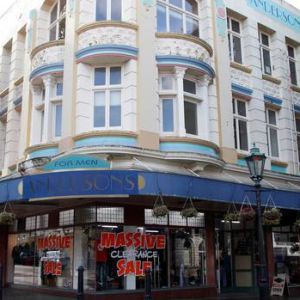Whanganui 2050: What will Whanganui's CBD look like in the future?

Significant work has gone into upgrading Whanganui's CBD over the last two decades, with more initiatives being planned to build on that foundation.
Will our heritage buildings and history take pride of place in 2050? Will we see an increase in parks and greenery? Are more people going to live in the city centre?
Mike Tweed reports.
Scott Flutey (WHS old boy) says there's already "a lot of good stuff happening" with Whanganui's Town Centre Regeneration Project had a lot of "really good, long-term action" in it.
"That's a 30-year strategy which came in 2016," Whanganui District Council's heritage adviser said.
"From my perspective, strengthening buildings is a huge part of our CBD's future, and I think we have a window of about 50 years to get a good group of our buildings seismically upgraded," he said.
"The more big, group projects we do, the better, because if you have multiple buildings taking part economy of scale is a major bonus, for both the engineers and building participants.
"We need to keep capitalising on all our heritage tourism industries, that's a good direction to keep going in."
Flutey said he would like to see most of the buildings in the bottom end of Victoria Ave and surrounding streets upgraded by 2050.
"I'd like to see that adapted reuse come in, and everyone asks, 'why we have apartment buildings upstairs?' or 'why can't we use those upstairs spaces?', and that's really something we should be aspiring to.
"We should be making more use of what we've already got, basically.
"Having more people living, as well as working and playing in that area, would be pretty amazing."
CBD living
Renowned Whanganui architect Bruce Dickson said retailing would change dramatically in the future, which in turn would create changes in the make-up of New Zealand regional centres "regardless of what people want to do".
"There will be less and less shops, there will be less banks or insurance agencies, all the kinds of things we're used to seeing in the centre of town," Dickson said.
"People are going to do all this all differently, whether it be online in or some other way, so we're going to have spaces in the centre of town which aren't going to function in the way there were built for.
"I've been banging on about this for the past 30 years, that the most obvious use for these buildings is residential accommodation.
"I lived in Whanganui in the 1950s and all those buildings were occupied, and they created their own life."
Dickson said installing a tunnel from Maria Place into Cook's Gardens and improving access to Queen's Park from Majestic Square would increase links to attractions in the centre of Whanganui.
"The scope for the development of the middle of town is huge, and we've got some superb old buildings there.
"If there are to be more people living in the centre of town then you're going to need more supply stores in the centre too, because I think you could get several thousand people living in there without too much difficulty."
'The same experience as Wellington'
Linking "key cultural areas" was important for the future of CBD, Town Centre Regeneration Project manager, Ellen Young, said, as well to create "more community share spaces".
"I'd like everyone to have the same kind of experience they would in Wellington," Young said.
"Having Pakaitore linked more to the river, then the river linking up to the Pukenamu area, and that linking to Cook's Gardens, because walking through that space is amazing.
"Focussing more on alternative transport for our streets like walking and cycling is also important because it's in line with climate change and creates a healthier population."
One of the Whanganui's strengths was being "weird and wonderful", Young said, and the city should communicate that better with visitors.
"We have some really weird stories and a weird identify, and we need to make that more visible, because it's quite wonderful.
"Having more people living town and getting away from that car-centric living mode is the way of the future.
"Generally having more people walking through our central city as opposed to driving would be great, because that would create more atmosphere and be good for the people as well."
A CBD for all
Imran Muhammed, Associate Professor at the School of People, Environment and Planning (Massey University), said Whanganui's CBD "should have something for everyone" by 2050.
"Slowing down the traffic into city centres is really important, making it more attractive to people, and less attractive to cars," Muhammed said.
"You need to include activities for everyone, from kids, to the aging population, to working families.
"If a city centre is monotonous, people won't want to visit that city, and the opposite of that is having the spill over effect to surrounding areas if that city centre is vibrant."
"Whanganui is a really beautiful place, and activating the CBD's proximity to the riverfront could set it apart from other places I think."
Mike Tweed
Whanganui Chronicle 25/8/20



